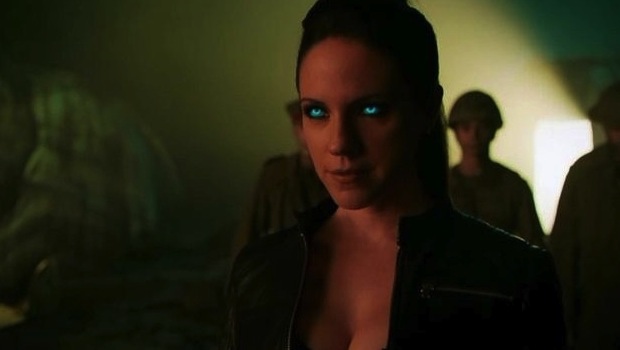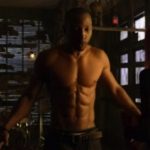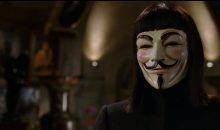Lost Girl: Sal-fae-cious
This post will feature many gratuitous images with saucy captions, just because.
“The way they pick TV shows is, they make one show. That show’s called a pilot. Then they show that one show to the people who pick shows, and on the strength of that one show they decide if they want to make more shows.”
I think about this Pulp Fiction quote often. I imagine that sometimes, the people who make shows walk into a room with the people who pick shows and have to speak but one sentence before the people who pick shows say something like “Here’s $30 million. Go make that.”
“Formula 51 features Samuel L. Jackson in a kilt.”
“Here’s $30 million. Go make that.”
“Snakes on a Plane is a movie about snakes on a plane.”
“Here’s $30 million. Go make that.”
“The main character of Lost Girl is a bisexual succubus.”
“Here’s $30 million. Go make that.”
Bisexual succubus. It’s a great premise, if, like me, you like a little titillation with your sic-fi/fantasy. But Lost Girl is more than the sum of its boy/girl parts; it’s a witty, fun romp through many different mythologies, with great acting and a fully realized world. Although the premise certainly doesn’t hurt the show’s chances of attracting viewers any.
Anna Silk stars as Bo, who at the beginning of the series finds out that her nasty habit of killing everyone she ever made out with was due to her supernatural-induced hunger, and not halitosis. In the first episode, Bo discovers her true nature: she is a fairy (fae), and must choose a side in order to live among her kind (like the Force [and duct tape] the fae have a light side and a dark side). Refusing to pick a side, Bo instead strikes out on her own, with her wisecracking, street-smart Russian sidekick-with-a-sketchy-past sidekick Kenzi at her side. Rounding out the main cast are Dyson, Bo’s male love interest, Lauren, Bo’s female love interest, Hale, a male Siren, and Trick, the owner of the local bar, which is also neutral fae ground, where Light and Dark can mix and mingle.
A few words about Trick. I hadn’t heard of Rick Howland before this series, but I thoroughly enjoy both Howland’s performance and how Trick’s character is written. Although Howland is 4’7”, his height isn’t a part of the series; it’s neither played for laughs nor derided. Like Bolivar Trask (played by Peter Dinklage in X-Men: Days of Future Past), Trick’s character could have been played by an
actor of more-average height; I’m pleased the casting agents took a chance on Howland.
The TV series that reminds me most of Lost Girl is Buffy the Vampire Slayer, although the sex, violence, and CGI are all accelerated for today’s audiences. Several characters in Lost Girl seem to have been inspired by characters on Buffy. British baddie Vex is the most obvious example here, as his character arc mimics that of Spike on Buffy. What initially drew me to Buffy the Vampire Slayer was its dialogue, its envelope-pushing, its strong female protagonist, and its refusal to take itself seriously. Lost Girl in all those respects seems like a natural extension of Buffy.
While vampire and werewolf movies and shows seem to follow similar patterns while occasionally carving out new rules for the creatures (I’m looking at you, sparkly vampires), stories about the fae seem to run the gamut, with no central mythology. Lost Girl is no different. In Lost Girl’s world, each fae has a specific set of powers. This mishmash-style of forming a mythology means an unlimited supply of fae with new powers. Vampires, werewolves, Norns, Red Caps, Will o’the Wisps, they’re all a part of this world.
You know what else is a part of this world? Sex. Bisexual succubus, remember? Bo needs sex to live, and she has a lot of it. Given that the show is on extended cable in the U.S. there’s no Game of Thrones-level of T&A; rather the lasciviousness often comes subtly wrapped in a babydoll, a pair of knee-high leather boots, or a pair of jeans and a six pack.
Lost Girl has finished four seasons and will return for a fifth season in fall 2014/spring 2015, meaning you have plenty of time to get caught up to speed before the new season starts. (Bonus: Season 2 is twice the length of all the other seasons, at 22 episodes, meaning more *ahem* bang for your buck.) Originally produced by Canada’s Show Case, Lost Girl episodes are currently available on Netflix, with reruns on Syfy. So what are you waiting for? Game of Thrones doesn’t start back up for another year; plenty of time to start up a guilty pleasure new series.
The rest of the tl;drs
Blank is a blanker version of blank: Lost Girl is like Buffy the Vampire Slayer, only 80% Willow/Tara and 20% ass-kicking, instead of the other way around.
Screen credits over/under: Over. Lost Girl has gone through six showrunners in its five seasons, which is more creative shakeup than I’d like. Surprisingly, the show hasn’t suffered from the numerous changes at the top.
Recommended if you like: Buffy the Vampire Slayer, Angel, Grimm, or anything that combines fantasy with T&A.
Better than I expected: I didn’t think I’d like the mythology mishmash at first, but it’s grown on me.
Worse than I hoped: Fae puns. Merciful Zeus, make the fae puns stop. (And yes, while I did title this post using a fae pun, I believe Lost Girl should do as I say and not as I do, and stop giving the shows titles like “Something Wicked This Fae Comes.”)
Lost Girl would work better as a(n): Showtime series, where they could push the boundary of sex and violence a little more. Seriously, it’s produced by Canada’s Showtime arm, Show Case. Why water the series down for cable TV?
Verdict: Lost Girl is next best thing to a new Joss Whedon TV series, now that Whedon’s moved on to the big screen.










